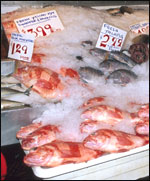
The dish on fish.
It’s been a winter of bad news for seafood lovers. A joint draft fish advisory from the U.S. Food and Drug Administration and the U.S. EPA added tuna — America’s second-most popular seafood after shrimp — to its list of mercury-containing fish that should be restricted in the diets of pregnant women and young children. A separate new study found unhealthy pollutants in far higher amounts in farmed salmon than in their wild kin. And, as reported in the February issue of Environmental Health Perspectives, Great Lakes’ sport-caught fish contain PCBs, DDT, and PBDEs, though the study did not show a link between their consumption and rising breast cancer rates.
Having a tough time keeping all these grim reports straight? Here’s an update on toxins to avoid, fish that contain them, and fish that are safer to eat.
Mercury
Fetuses, infants, and young children are at greatest risk of harm from mercury, which can damage developing brains and nervous systems. As the Harvard School of Public Health warned in a study published in the Journal of Pediatrics earlier this month, fetuses and young children exposed to methylmercury can suffer irreversible damage to the heart as well as permanently impaired brain growth.
Because mercury is stored in our bodies, just as it is in those of fish, women planning to have children should also avoid high-mercury fish well before they become pregnant. According to a recent update by the Centers for Disease Control, 16 percent of American women of child-bearing age have levels of mercury in their blood high enough to indicate increased chance of harm to their fetuses.

To market, to market, to buy a fresh fish.
Adults can suffer harm, as well: In April 2003, Environmental Health Perspectives reported that 89 percent of study subjects — chosen if they ate a significant amount of fish or showed symptoms consistent with mercury poisoning, such as fatigue, headache, decreased memory, and joint pain — had blood mercury levels above the EPA’s safety threshold of 5 micrograms per liter.
The FDA and EPA advise that young children, pregnant women, nursing mothers, and women of childbearing age not eat more than two or three meals, or 12 ounces total, of fish or shellfish a week. They should limit high-mercury fish to one serving per week.
To be safest, however, The Green Guide and the Environmental Working Group recommend limiting moderate-mercury fish to one meal a month, and bypassing high-mercury fish completely. In addition, our list of high-mercury fish is longer than the FDA’s, which includes only king mackerel, shark, swordfish, and tilefish (see fish lists below).
POPs
Polychlorinated biphenyls (PCBs) — neurotoxic, hormone-disrupting chemicals banned in the U.S. since 1977 — were found at levels seven times higher in farmed salmon than in wild ones, according to a study published in Science in January 2004. PCBs are persistent organic pollutants (POPs), which accumulate in animal fats. Because most farmed salmon are raised on feed that includes ground-up fish — and sometimes other animals, such as cattle — their bodies collect POPs. PCBs are also found at high levels in fish from polluted water bodies, varying from locale to locale; state health advisories list which fish should not be consumed by children, pregnant or nursing women, and women of childbearing age. Other POPs found in fish include the organochlorine pesticide dieldrin and dioxins, which result from chlorine paper bleaching and manufacturing and incineration of PVC plastic.
High mercury: Atlantic halibut, king mackerel, oysters (Gulf Coast), pike, sea bass, shark, swordfish, tilefish (golden snapper), tuna (steaks and canned albacore).
High POPs: Farmed salmon. Limit to once a month if pregnant/nursing. Check TheGreenGuide.com for updates on POPs in other farmed fish.
Fish to Eat

The gift of crab.
Moderate mercury: Alaskan halibut, black cod, blue (Gulf Coast) crab, cod, dungeness crab, Eastern oysters, mahimahi, blue mussels, pollack, tuna (canned light). (Children and pregnant or nursing women are advised to eat no more than one from this list, once a month.)
Low mercury: Anchovies, Arctic char, crawfish, Pacific flounder, herring, king crab, sanddabs, scallops, Pacific sole; tilapia, wild Alaska and Pacific salmon; farmed catfish, clams, striped bass, and sturgeon. (Children and pregnant or nursing women can safely eat two to three times a week.)
Take note, though, that low-mercury but overfished or destructively harvested species — such as Atlantic cod, Atlantic flounder, Atlantic sole, Chilean sea bass, monkfish, orange roughy, shrimp, and snapper — should be avoided for the environment’s sake.
Low POPs: Wild Alaska and California salmon (fresh or canned).
Check with your state’s department of health for POP advisories before eating fish from local waters.
The Final Word
Limit fish consumption by category, not individual species. For example, both cod and mahimahi are moderate-mercury fish, and only one from this category should be eaten per month — not one meal of cod and one of mahimahi.
If you’re in a high-risk group, don’t eat the skin and fatty parts of fish, where POPs collect. Eat grilled, baked, and broiled rather than fried fish, to avoid fat.
And, finally, don’t be daunted by the prospect of remembering all this info — you don’t have to. Just download The Green Guide‘s Fish Picks card [PDF], a handy pocket-sized seafood-rating guide.
For more info on which fish to avoid and which fish you can safely gobble up, see the Environmental Working Group’s website, the EPA’s Fish Advisories webpage, and the EPA’s National Listing of Fish and Wildlife Advisories.

